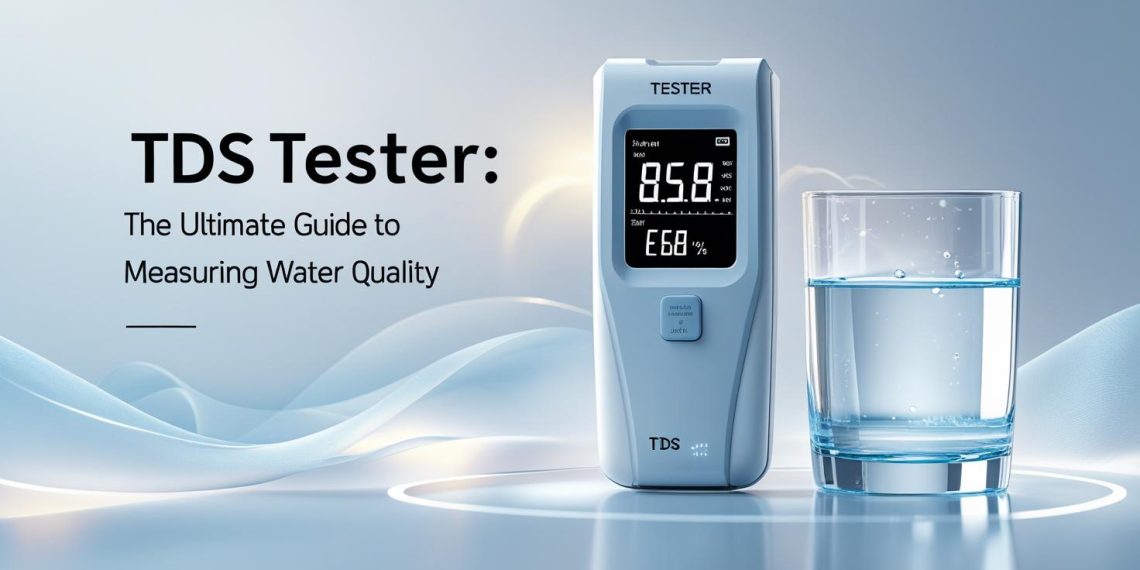Water quality is a crucial factor for maintaining a healthy lifestyle, protecting household appliances, and ensuring the proper functioning of water treatment systems. One of the most effective tools for assessing water quality is a TDS tester. At AMPAC USA, we understand the importance of clean and safe drinking water, which is why we emphasize the role of TDS meters in both residential and industrial applications. This comprehensive guide explores everything you need to know about TDS testers, including what they are, how they work, why they matter, and how to choose the best one for your needs.
What is a TDS Tester?
A TDS tester, also known as a TDS meter, is a device used to measure the Total Dissolved Solids (TDS) in water. TDS refers to the combined content of all inorganic and organic substances, including minerals, salts, and metals, that are dissolved in water. These solids are usually measured in parts per million (ppm).
The TDS value of water serves as a direct indicator of its purity. For example:
-
0–50 ppm: High-quality drinking water (ultra-pure).
-
50–150 ppm: Acceptable range for most households.
-
150–300 ppm: Average tap water.
-
300–500 ppm: Hard water, not ideal for drinking.
-
Above 500 ppm: Considered unsafe and requires treatment.
A TDS tester helps identify whether your water meets safe standards and whether filtration or reverse osmosis treatment is necessary.
How Does a TDS Tester Work?
TDS testers work on the principle of electrical conductivity (EC). Since dissolved salts and minerals are conductive, a TDS meter measures the electrical conductivity of water and then converts it into TDS levels in ppm.
Basic Steps:
-
Immerse the probe: Place the probe of the tester into a water sample.
-
Measure conductivity: The tester calculates the electrical conductivity between two electrodes.
-
Display results: It converts the reading into a TDS value and displays it on the screen.
Most modern TDS testers are digital, providing quick and accurate readings. Some advanced models also display temperature and have automatic temperature compensation (ATC) for precise measurements.
Why is TDS Measurement Important?
The significance of measuring TDS cannot be overstated, especially when it comes to drinking water quality and industrial water treatment. High levels of dissolved solids can affect taste, safety, and efficiency.
1. Ensures Safe Drinking Water
A TDS tester helps determine whether your drinking water contains excessive dissolved impurities like chlorine, lead, arsenic, or nitrates. Elevated TDS levels often indicate contamination, which can lead to health problems.
2. Maintains Efficiency of Water Filters
Using a TDS tester allows you to monitor the performance of reverse osmosis (RO) systems or other water filters. A rising TDS value might mean the filter membranes need replacement.
3. Prevents Scale and Corrosion
High TDS water can cause scaling and corrosion in pipes, boilers, and appliances. Regular monitoring helps prevent costly maintenance and prolongs the life of equipment.
4. Improves Taste and Appearance
Water with excessive minerals or salts often has an unpleasant taste, odor, or cloudy appearance. A TDS tester helps you identify the cause and take corrective actions.
Applications of TDS Testers
TDS testers have a wide range of applications, making them essential tools in various industries and households.
1. Residential Use
-
Checking tap water or well water quality.
-
Monitoring filtered or bottled water.
-
Ensuring optimal performance of water softeners and RO systems.
2. Industrial Use
-
Water treatment plants and desalination units.
-
Food and beverage manufacturing.
-
Pharmaceuticals and laboratories.
-
Aquariums and hydroponics, where water quality directly impacts plants and aquatic life.
3. Commercial Applications
-
Hotels, restaurants, and cafes rely on TDS testers to maintain water quality for cooking and beverages.
-
Car wash services use TDS testers to ensure spot-free rinses.
Ideal TDS Levels for Drinking Water
According to the World Health Organization (WHO) and the Environmental Protection Agency (EPA), water with a TDS level of up to 500 ppm is generally safe for consumption. However, most experts recommend a range of 50–150 ppm for drinking water to ensure both safety and pleasant taste.
Here is a quick breakdown:
-
Below 50 ppm: Ultra-pure water (can taste flat due to lack of minerals).
-
50–150 ppm: Excellent taste and safe for drinking.
-
150–300 ppm: Acceptable but may have slight hardness.
-
300–500 ppm: Requires filtration for better taste and safety.
-
Above 500 ppm: Unsafe and should not be consumed without treatment.
How to Use a TDS Tester Effectively
Using a TDS tester is straightforward, but following the right steps ensures accurate results:
-
Turn on the device: Press the power button to activate the tester.
-
Remove protective cap: Most testers come with a protective cap to shield the electrodes.
-
Immerse in water: Dip the probe about 2–3 cm into the water sample.
-
Wait for reading: Allow the reading to stabilize (usually 2–5 seconds).
-
Record the value: Note the ppm displayed.
-
Rinse the probe: After use, rinse with distilled water and replace the protective cap.
Tips for Accurate TDS Measurements
-
Use clean containers: Avoid contamination from dirty cups or bottles.
-
Avoid air bubbles: Submerge the probe without trapping air bubbles.
-
Calibrate regularly: Some models require periodic calibration for accuracy.
-
Measure at room temperature: Extreme temperatures can affect readings unless the tester has ATC.
Choosing the Best TDS Tester
When selecting a TDS tester for your home or business, consider the following factors:
1. Accuracy and Range
Choose a tester with an accuracy of ±2% and a measurement range of 0–9999 ppm to cover all possible water conditions.
2. Digital Display
A clear LCD screen makes it easier to read results quickly.
3. Automatic Temperature Compensation (ATC)
ATC ensures that temperature fluctuations do not affect TDS readings.
4. Multi-functionality
Some advanced models combine TDS, EC, and temperature measurements in one device.
5. Durability
A robust build and water-resistant body are essential for long-term use.
TDS Testers vs. Laboratory Testing
While TDS testers provide quick and convenient results, they do not reveal the specific types of contaminants present in water. For a detailed analysis, laboratory testing is recommended. However, TDS meters remain an excellent tool for regular monitoring and detecting sudden changes in water quality.
TDS Testers and Reverse Osmosis Systems
Reverse Osmosis (RO) is one of the most effective methods for reducing TDS levels in water. A TDS tester is essential for:
-
Monitoring RO performance.
-
Checking membrane efficiency.
-
Determining when to replace filters.
At AMPAC USA, our RO systems are designed to reduce TDS to the safest possible levels, ensuring pure, great-tasting water for your family or business.
Benefits of Using a TDS Tester
-
Affordable and Easy to Use: Compact design and user-friendly interface.
-
Real-Time Results: Quick analysis in seconds.
-
Portable: Lightweight and convenient for travel or field testing.
-
Versatile: Suitable for homes, offices, aquariums, and industries.
Maintaining Your TDS Tester
To ensure long-lasting performance:
-
Store in a dry place.
-
Avoid immersing beyond the probe area.
-
Clean electrodes with distilled water after each use.
-
Replace batteries when readings become inconsistent.
AMPAC USA – Your Partner in Water Quality
At AMPAC USA, we provide premium water treatment systems and testing equipment that meet global standards for water purification. Whether you are looking for residential reverse osmosis systems, industrial watermakers, or high-quality TDS testers, we have the right solutions.
Conclusion
A TDS tester is an indispensable tool for anyone who wants to ensure their water is clean, safe, and free from harmful contaminants. Regular monitoring of water quality not only improves health but also protects appliances and enhances the taste of drinking water.
By investing in a reliable TDS tester and a high-performance reverse osmosis system from AMPAC USA, you can take full control of your water quality. With the right knowledge and tools, maintaining pure water for your family or business becomes effortless.












https://plitkastroy33.ru/news/chto-takoe-rechnoy-pesok-i-ego-osobennosti/
[url=http://piony-msk.ru/]Пионы купить в Москве букет с доставкой на дом недорого[/url]
Важно помнить, что пионы являются сезонными цветами, и их следует приобретать в определённые месяцы.
What happens when an octopus engages with art?
[url=https://parimatch-download.in/]parimatch mobile app download[/url]
When the Japanese artist Shimabuku was 31 years old, he took an octopus on a tour of Tokyo. After catching it from the sea with the help of a local fisherman in Akashi, a coastal city over 3 hours away from the Japanese capital by train, he transported the live creature in a temperature-controlled tank of seawater to show it the sights of Tokyo before returning it safely to its home the same day.
https://parimatch-download.in/
parimatch app india
“I thought it would be nice,” the artist, now 56, said about the experience, over a video call from his home in Naha, Japan. “I started to travel when I was 20 years old. But octopuses, maybe they don’t travel so much — and when they do, they are just going to be eaten. I wanted to take an octopus on a trip, but not to be eaten.”
Documenting it on video, Shimabuku took the octopus to see the Tokyo Tower, before visiting the Tsukiji fish market, where the animal “reacted very strongly” to seeing other octopuses on sale, the artist said. “Octopuses are smart — maybe he told his experience to his octopus friends in the sea (after returning).”
The interspecies day trip, resulting in the 2000 video work “Then, I Decided to Give a Tour of Tokyo to the Octopus from Akashi,” kickstarted a series of projects Shimabuku has undertaken over the decades that engage with octopuses in playful, inquisitive ways. A portion of this work is currently on show in the UK, in two exhibitions that explore humanity’s relationship with nature and animal life: “More than Human” at the Design Museum in London (through October 5) and “Sea Inside” at the Sainsbury Centre in Norwich (through October 26).
Fascinated by what the sea creatures might think, feel, or like, Shimabuku has documented their reactions to various experiences, from the city tour of Tokyo to being given specially crafted artworks. “They have a curiosity,” he said. “For some other animals, it’s only about eating and making love. But I think octopuses have time to wander — time for hobbies.”
When he lived in the Japanese city of Kobe, Shimabuku would go on fishing trips with local fisherman, taking the opportunity to learn about octopuses. “Traditionally we catch octopuses in empty ceramic pots — that’s my hometown custom,” he said. Fishermen would throw hundreds of pots into the sea, wait two days, then retrieve them — finding octopuses inside. “Octopuses like narrow spaces so they just come into it,” explained Shimabuku.
When he saw the animals within the pots, he discovered they were “carrying things”: shells, stones, even bits of broken beer bottles. He began to save the small objects the octopuses had gathered — “a collection of a collection,” he said.
[url=https://skaskanew.ru/]skaskanew.ru[/url][url=https://gratiavitae.ru/]gratiavitae.ru[/url][url=https://slame-rp.ru/]slame-rp.ru[/url][url=https://agrorubo.ru/]agrorubo.ru[/url][url=https://flamandrose.ru/]flamandrose.ru[/url][url=https://fantastikmir.ru/]fantastikmir.ru[/url][url=https://pavel3333.ru/]pavel3333.ru[/url][url=https://vladgate.ru/]vladgate.ru[/url][url=https://vr-point.ru/]vr-point.ru[/url][url=https://homeimprovementstore.ru/]homeimprovementstore.ru[/url][url=https://craftingmaterials.ru/]craftingmaterials.ru[/url][url=https://modernlighting.ru/]modernlighting.ru[/url]
[url=https://skaskanew.ru/]skaskanew.ru[/url][url=https://gratiavitae.ru/]gratiavitae.ru[/url][url=https://slame-rp.ru/]slame-rp.ru[/url][url=https://agrorubo.ru/]agrorubo.ru[/url][url=https://flamandrose.ru/]flamandrose.ru[/url][url=https://fantastikmir.ru/]fantastikmir.ru[/url][url=https://pavel3333.ru/]pavel3333.ru[/url][url=https://vladgate.ru/]vladgate.ru[/url][url=https://vr-point.ru/]vr-point.ru[/url][url=https://homeimprovementstore.ru/]homeimprovementstore.ru[/url][url=https://craftingmaterials.ru/]craftingmaterials.ru[/url][url=https://modernlighting.ru/]modernlighting.ru[/url]
skaskanew [url=https://skaskanew.ru/]more info on this page[/url] gratiavitae[url=https://gratiavitae.ru/]this website[/url] slame-rp [url=https://slame-rp.ru/]here[/url] agrorubo.ru [url=https://agrorubo.ru/]read more[/url] flamandrose [url=https://flamandrose.ru/]read more[/url] fantastikmir.ru [url=https://fantastikmir.ru/]example[/url] pavel3333 [url=https://pavel3333.ru/]see more[/url] vladgate.ru [url=https://vladgate.ru/]vladgate[/url] vr-point.ru [url=https://vr-point.ru/]more info on this page[/url] homeimprovementstore.ru [url=https://homeimprovementstore.ru/]learn more about this[/url] craftingmaterials.ru [url=https://craftingmaterials.ru/]see more[/url] modernlighting.ru [url=https://modernlighting.ru/]source[/url] digitalartprints.ru [url=https://digitalartprints.ru/]visit the site for details[/url] beautyandwellness [url=https://beautyandwellness.ru/]this website[/url]
skaskanew [url=https://skaskanew.ru/]this website[/url] gratiavitae.ru [url=https://gratiavitae.ru/]see more[/url] slame-rp.ru [url=https://slame-rp.ru/]example[/url] agrorubo.ru [url=https://agrorubo.ru/]visit the site for details[/url] flamandrose [url=https://flamandrose.ru/]see more[/url] fantastikmir.ru [url=https://fantastikmir.ru/]more info on this page[/url] pavel3333.ru [url=https://pavel3333.ru/]example[/url] vladgate.ru [url=https://vladgate.ru/]visit the site for details[/url] vr-point.ru [url=https://vr-point.ru/]that[/url] homeimprovementstore [url=https://homeimprovementstore.ru/]see more[/url] craftingmaterials.ru [url=https://craftingmaterials.ru/]click here to learn more[/url] modernlighting [url=https://modernlighting.ru/]modernlighting[/url] digitalartprints [url=https://digitalartprints.ru/]details[/url] beautyandwellness [url=https://beautyandwellness.ru/]read more[/url]
skaskanew.ru [url=https://skaskanew.ru/]page[/url] gratiavitae.ru [url=https://gratiavitae.ru/]example[/url] slame-rp.ru [url=https://slame-rp.ru/]slame-rp[/url] agrorubo.ru [url=https://agrorubo.ru/]here[/url] flamandrose [url=https://flamandrose.ru/]learn more[/url] fantastikmir [url=https://fantastikmir.ru/]click here[/url] pavel3333.ru [url=https://pavel3333.ru/]link[/url] vladgate.ru [url=https://vladgate.ru/]source[/url] vr-point [url=https://vr-point.ru/]read more[/url] homeimprovementstore [url=https://homeimprovementstore.ru/]visit the site for details[/url] craftingmaterials.ru [url=https://craftingmaterials.ru/]details[/url] modernlighting [url=https://modernlighting.ru/]example[/url] digitalartprints.ru [url=https://digitalartprints.ru/]details[/url] beautyandwellness [url=https://beautyandwellness.ru/]visit the site[/url]
skaskanew.ru [url=https://skaskanew.ru/]example[/url] gratiavitae.ru [url=https://gratiavitae.ru/]gratiavitae.ru[/url] slame-rp.ru [url=https://slame-rp.ru/]slame-rp[/url] agrorubo [url=https://agrorubo.ru/]that[/url] flamandrose [url=https://flamandrose.ru/]link[/url] fantastikmir.ru [url=https://fantastikmir.ru/]see more[/url] pavel3333 [url=https://pavel3333.ru/]page[/url] vladgate.ru [url=https://vladgate.ru/]page[/url] vr-point.ru [url=https://vr-point.ru/]go to[/url] homeimprovementstore.ru [url=https://homeimprovementstore.ru/]here[/url] craftingmaterials [url=https://craftingmaterials.ru/]this website[/url] modernlighting.ru [url=https://modernlighting.ru/]read more[/url] digitalartprints [url=https://digitalartprints.ru/]digitalartprints.ru[/url] beautyandwellness [url=https://beautyandwellness.ru/]click here to learn more[/url]
skaskanew.ru [url=https://skaskanew.ru/]that[/url] gratiavitae.ru [url=https://gratiavitae.ru/]site[/url] slame-rp.ru [url=https://slame-rp.ru/]slame-rp[/url] agrorubo [url=https://agrorubo.ru/]online[/url] flamandrose [url=https://flamandrose.ru/]that[/url] fantastikmir.ru [url=https://fantastikmir.ru/]this website[/url] pavel3333 [url=https://pavel3333.ru/]go to[/url] vladgate.ru [url=https://vladgate.ru/]learn more about this[/url] vr-point [url=https://vr-point.ru/]visit the site[/url] homeimprovementstore.ru [url=https://homeimprovementstore.ru/]learn more about this[/url] craftingmaterials.ru [url=https://craftingmaterials.ru/]page[/url] modernlighting.ru [url=https://modernlighting.ru/]online[/url] digitalartprints.ru [url=https://digitalartprints.ru/]example[/url] beautyandwellness [url=https://beautyandwellness.ru/]visit the site[/url]
skaskanew [url=https://skaskanew.ru/]visit the site[/url] gratiavitae.ru [url=https://gratiavitae.ru/]source[/url] slame-rp.ru [url=https://slame-rp.ru/]visit the site[/url] agrorubo.ru [url=https://agrorubo.ru/]visit the site[/url] flamandrose [url=https://flamandrose.ru/]example[/url] fantastikmir.ru [url=https://fantastikmir.ru/]example[/url] pavel3333.ru [url=https://pavel3333.ru/]learn more[/url] vladgate.ru [url=https://vladgate.ru/]here[/url] vr-point [url=https://vr-point.ru/]that[/url] homeimprovementstore.ru [url=https://homeimprovementstore.ru/]click here[/url] craftingmaterials.ru [url=https://craftingmaterials.ru/]link[/url] modernlighting.ru [url=https://modernlighting.ru/]click here[/url] digitalartprints.ru [url=https://digitalartprints.ru/]read more[/url] beautyandwellness.ru [url=https://beautyandwellness.ru/]this website[/url]
skaskanew [url=https://skaskanew.ru/]page[/url] gratiavitae.ru [url=https://gratiavitae.ru/]link[/url] slame-rp [url=https://slame-rp.ru/]source[/url] agrorubo.ru [url=https://agrorubo.ru/]source[/url] flamandrose [url=https://flamandrose.ru/]the article[/url] fantastikmir.ru [url=https://fantastikmir.ru/]source[/url] pavel3333 [url=https://pavel3333.ru/]online[/url] vladgate.ru [url=https://vladgate.ru/]the article[/url] vr-point [url=https://vr-point.ru/]read more[/url] homeimprovementstore [url=https://homeimprovementstore.ru/]site[/url] craftingmaterials [url=https://craftingmaterials.ru/]page[/url] modernlighting.ru [url=https://modernlighting.ru/]learn more about this[/url] digitalartprints.ru [url=https://digitalartprints.ru/]source[/url] beautyandwellness [url=https://beautyandwellness.ru/]beautyandwellness[/url]
skaskanew [url=https://skaskanew.ru/]details[/url] gratiavitae [url=https://gratiavitae.ru/]see more[/url] slame-rp.ru [url=https://slame-rp.ru/]visit the site[/url] agrorubo [url=https://agrorubo.ru/]details[/url] flamandrose [url=https://flamandrose.ru/]click here[/url] fantastikmir.ru [url=https://fantastikmir.ru/]fantastikmir[/url] pavel3333.ru [url=https://pavel3333.ru/]page[/url] vladgate [url=https://vladgate.ru/]click here[/url] vr-point [url=https://vr-point.ru/]this website[/url] homeimprovementstore [url=https://homeimprovementstore.ru/]page[/url] craftingmaterials.ru [url=https://craftingmaterials.ru/]link[/url] modernlighting [url=https://modernlighting.ru/]source[/url] digitalartprints [url=https://digitalartprints.ru/]digitalartprints[/url] beautyandwellness [url=https://beautyandwellness.ru/]site[/url]